Dark Winter is tedious bioterror fanfiction written to inspire public fear of the smallpox virus and plead for the continued relevancy of its eradicators
In which eugyppius reads another pandemic wargame so you don't have to.
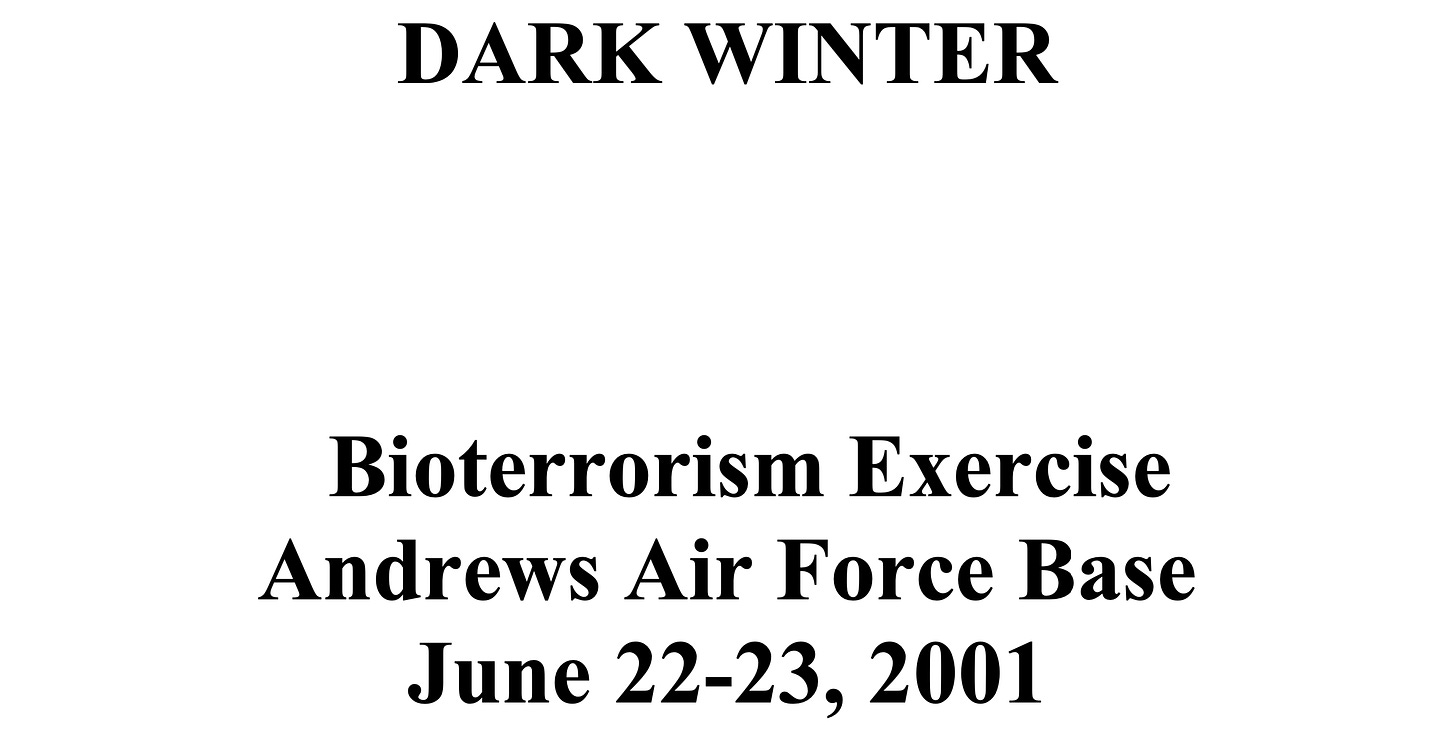
“Eugyppius,” said critics of the plague chronicle, “everybody knows the SPARS pandemic is a dumb exercise in public health communication. Of course there are no lockdowns in there, even though many have claimed otherwise for a very long time now, in bestselling books and all over the internet.”
“Eugyppius,” said critics of the plague chronicle, “‘Operation Lockstep’ is obviously a foolish globalist fantasy of the Rockefeller Foundation, not even related to pandemic planning, even though many have spent years saying the opposite to massive audiences and occasionally also in your comments.”
“Eugyppius,” critics of the plague chronicle said finally, “why are you not looking at the real evidence for a plandemic? Are you trying to fool us? Everyone knows that Dark Winter is where the bodies are buried. If only you would read Dark Winter, then you would finally see that lockdowns have been planned by the defence sector since 2001. It is all an elaborate operation, naive Eugyppius. Why are you hiding this truth from your readers?”
“Critics of the plague chronicle,” answers a sniffling, hayfever-stricken Eugyppius from his small octagonal writing tower above the Elbe, where a light breeze wafts through the open windows, and a neighbour will not stop trimming his hedges with some odious buzzing device, “I have read all pandemic tabletop exercises and wargames of any note, two years ago, on the side of a Swiss mountain. There are no lockdowns in any of them. You may retreat to other documents for a time, but know that my series is coming for them too. One by one your castles will fall.”
It is fun to laugh about the stupidity of SPARS and “Lock Step,” but Dark Winter – and in fact everything coming out of the Johns Hopkins Center for Health Security – gives me the creeps. This is not because this stuff is especially prescient or intelligent, and it is not because it contains any long-standing plan for lockdowns that defence planners implemented with the outbreak of SARS-2 either. There are grave intellectual defects here as elsewhere, and the importance of these documents is wildly overemphasised. But with Dark Winter, we leave the nerfworld of communications majors and consultants and enter the rather higher realm of government policy and defence strategy – where we find nothing but the same self-promotional tactics and manipulative virus mythology that prevails everywhere else. These people have been lying about viruses and overselling outbreak threats for over twenty years now, and especially after 2020 that’s not very funny.
This will be a serious post.
To understand Dark Winter, you need to know that the pandemicist establishment has gone through two major eras in the twenty-first century:
1) In the beginning was the Era of Biodefence, dominated by unusual fantasies of biological warfare and the artificially promulgated fear that villainous antiliberal dictators like Saddam Hussein were secretly developing weapons of mass destruction because they hate democracy. In this era, grant funding flowed primarily from the defence sector, forcing opportunists like the arch-pandemicist smallpox eradicator Donald Henderson to align their programme with defence interests. This era came to an end after the Iraq War.
2) Afterwards came the Era of Big Philanthropy, in which tech magnates and their organisations refocused pandemicist attention on the civilian world. In this new era, emerging pandemic pathogens replaced biowarfare as the threat to be countered. Henderson’s pandemic think-tank, founded as the Johns Hopkins Center for Civilian Biodefense Strategies (CCBS), managed the transition by changing its name to the Center for Health Security and accepting millions in grants from the Open Philanthropy Project in 2017. With these new funds came a mandate to focus on “global catastrophic risks.” Just like that, the third-worlders eclipsed the bioterrorists. This transition is especially important for us, because it was primarily in the Era of Big Philanthropy that the pandemicists began fantasising about elaborate mitigationist responses to novel virus outbreaks. In the older Era of Biodefence, the emphasis lies rather on strategic implications, and the public health aspect is a secondary concern.
Dark Winter was a “tabletop exercise” from the Era of Biodefence, organised by the CCBS in partnership with the freshly minted ANSER Institute for Homeland Security. It was held at Andrews Airforce Base in Washington, D.C. on 22–23 June 2001. Impetus came from the Center for Strategic and International Studies, a leading defence-sector think-tank, which asked ANSER and the CCBS to throw together “an exercise in which senior former officials would respond to a national security crisis caused by use of a biological weapon.” A great part of the funding came from the Oklahoma National Memorial Institute for the Prevention of Terrorism, a non-profit founded to commemorate the 1995 bombing of the Murrah Federal Building.
The Dark Winter scenario is plainly not a future prophecy, nor is it even remotely plausible. It’s rather a tiresome pretzel concocted to distribute limelight among the core concerns of each of the participating organisations. It features a smallpox outbreak, the obsession of the Henderson-founded CCBS. This outbreak is brought about by a bioterror attack on Oklahoma and two other states, so as to satisfy the Oklahoma terror-preventers. It is strongly suggested that this attack was carried out by Iraqi proxies to encourage the withdrawal of American forces from the Middle East, so the defence strategists who commissioned this cut-rate theatrical piece got what they wanted too.
Dark Winter also had a deeper purpose. In 1986, a WHO panel recommended that the last remaining, officially declared smallpox virus samples in the United States and Russia be destroyed. The deadline for this destruction was set first for 1993, and then for 1999. The Clinton administration moved to enact this recommendation, but at the last minute, forces in the American defence and intelligence sectors fought to save the last remaining viable smallpox virus. Months before the scheduled 1999 destruction, there emerged a federal intelligence assessment claiming, on the strength of fairly flimsy evidence, that Iraq, North Korea and Russia were likely hiding smallpox samples for the purposes of clandestine biowarfare programmes. Clinton relented and agreed to let the CDC keep their smallpox. Two years later, the Center for Strategic and International Studies commissioned Dark Winter to dramatise, for the benefit of the media, what an Iraqi smallpox attack on the United States might look like. This was a publicity operation, one
intended to increase awareness of the scope and character of the threat posed by biological weapons among senior national security experts and to catalyze actions that would improve prevention and response strategies.
In other words, Dark Winter was the final act in a small drama staged by the intelligence community for the purposes of convincing the president to keep smallpox around, presumably for purposes of bioweapons research. Henderson and his CCBS, desperate to remain relevant twenty years after the WHO had declared his career-making virus eradicated, were happy to help out.
The best source for Dark Winter is a paper published in Clinical Infectious Diseases in 2002 by Tara O’Toole, Mair Michael and Thomas V. Ingelsby, under the title “Shining Light on ‘Dark Winter’.” The paper is useful especially for reporting the decisions of the exercise participants and the rationale behind various features of the exercise, and it’s what I have been, and will be, quoting from here. Before a recent Center for Health Security website redesign, readers could also download a 44-page Dark Winter script with all of the fake memos and talking points provided to the event participants, and watch an eight-minute video containing various slides and the boundlessly ridiculous “news reports” screened to event participants. These can still be found on the Wayback Machine. I’ve studied them all, but find they don’t add much to the O’Toole/Michael/Ingelsby paper.
Dark Winter simulated mock meetings of the National Security Council, whose members were played by twelve politically prominent participants. Additionally, five journalists – including the notorious WMD propagandist Judith Miller – “observed the deliberations of the simulated NSC and participated in a mock press conference during the exercise.” All this played out before an audience of “ca. 50 people with current or former policy or operational responsibilities related to biological weapons preparedness.”
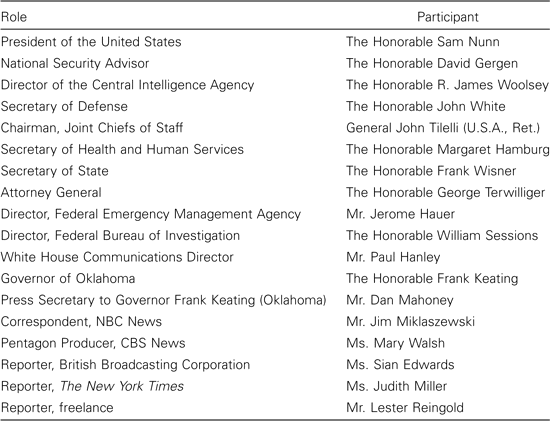
We are assured that, “To the extent possible, the decisions made” by the participants “were incorporated into the evolving exercise, so that key decisions affected the evolution and outcomes of the scenario.” The pre-filmed news segments show that this extent cannot have been very great. Nor is the National Security Council responsible for coordinating American public health policy, so the participants never had any meaningful opportunity to change the course of the outbreak via their actions. In fact, the whole point is that there is nothing to do, because the CDC stockpile of 15.4 million smallpox vaccine doses is woefully inadequate.
Dark Winter features three NSC meetings on 9, 15 and 22 December 2002. The first meeting occurs after 3000 people were infected with smallpox virus during “three simultaneous attacks in three separate shopping malls in Oklahoma City, Philadelphia and Atlanta” – though at this point only 50 cases have been identified.
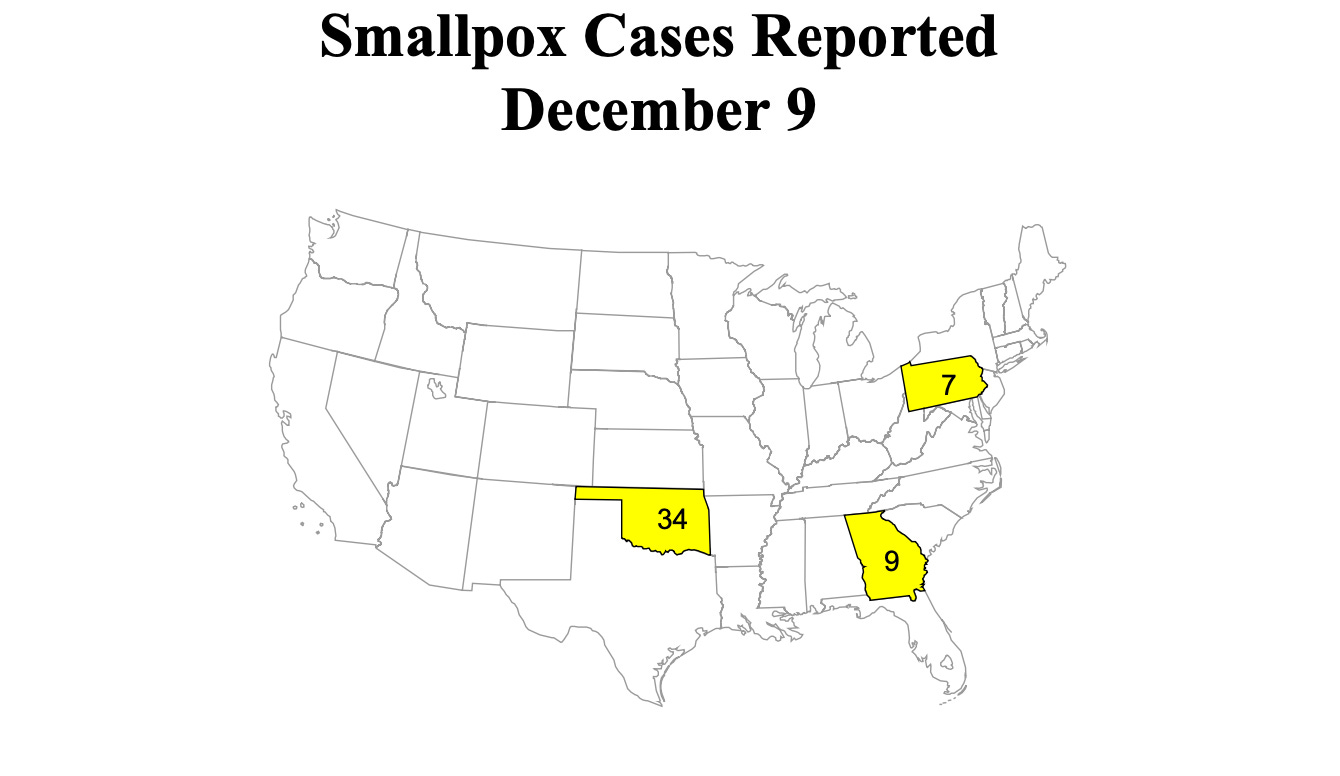
The scenario authors assume that 20% of the US population has lingering immunity to smallpox, where routine vaccinations stopped in 1972, but I can’t see that they ever take this number into account in their crude model of virus transmission. They also very insanely propose a reproduction number of 10 for variola, “based on an analysis of 34 instances of smallpox importation into Europe between 1958 and 1973,” which they cherry-picked to achieve the highest numbers:
These smallpox importations were instances in which a person contracted smallpox in a country where the disease still occurred naturally and then unknowingly brought the virus back to a country that no longer had endemic smallpox. Ten of those importations occurred in the months June–November, when the smallpox transmission rate is at its seasonal low. These importations were not included in further analysis, because the smallpox attack simulated in Dark Winter took place in December, when the smallpox transmission rate is at its seasonal high.
As always, vaccination is the focal point of the imaginary response. The scenario authors know that smallpox vaccination is dangerous; it’s not mentioned in the paper, but the script estimates that “possibly lethal vaccine complication[s]” might occur at a rate as high as 1 in 5000 vaccinations.
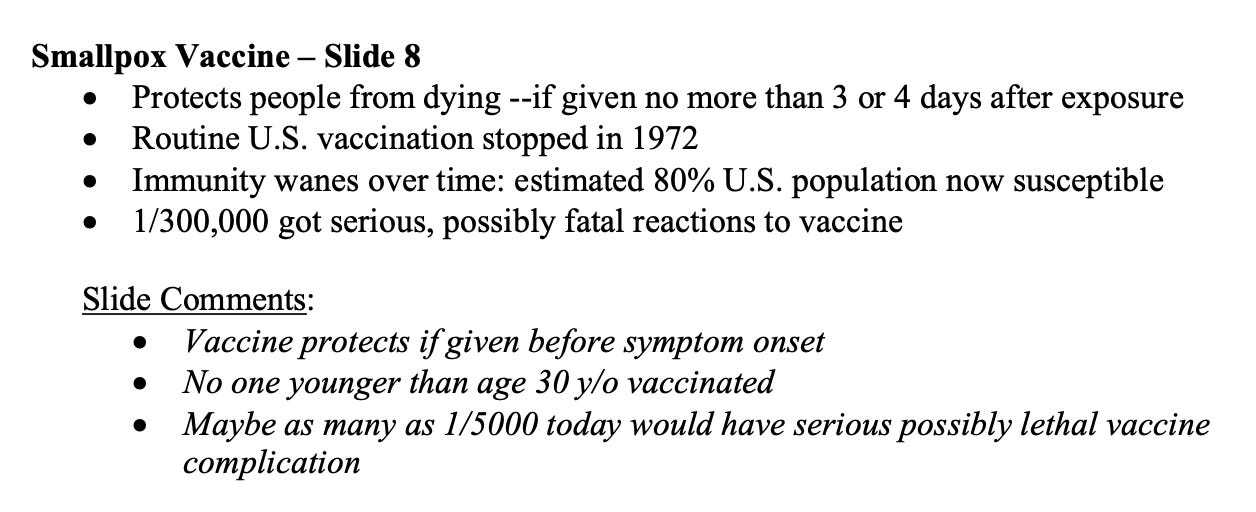
At their first meeting, the fake NSC was given three options: 1) a “ring vaccination policy,” in which vaccines would be administered to “patient contacts and essential personnel” in each of the three attacked states; 2) a “combination ring/mass vaccination policy,” in which, in addition to 1), the three cities at the centre of the the outbreaks would receive enough vaccine to jab everybody; and 3) a “combination ring/mass distribution policy,” in which, in addition to 2), the other 47 states would get 125,000 doses to use however. In each case, the Defense Department reserves 2.5 million doses for its own forces.
The participants elected to hoard vaccine and went for the first option, effectively waiting for cases to rise beyond their ability to vaccinate. As we saw above, though, it hardly matters; the script was set in stone and the outbreak would unfold identically whatever they decided to do.
By the second meeting, on 15 December, there are 2000 identified cases in 15 states, and 300 have died.
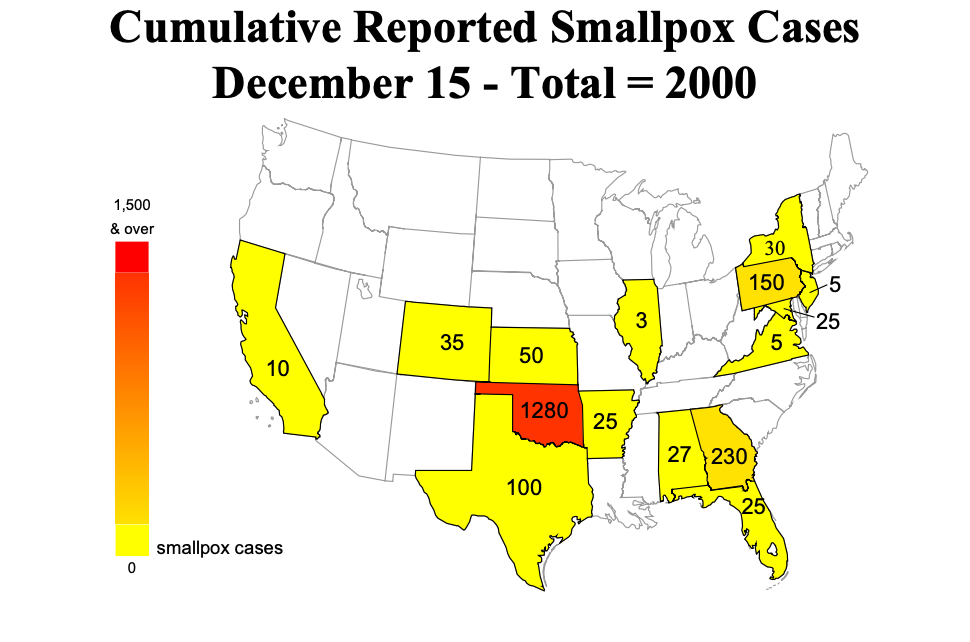
Vaccine production is kicked into overdrive; “three US drug companies agree to produce new vaccine at the rate of 6 million doses per month, with the first deliveries in 5 weeks.” Also, Russia offers 4 million doses to the US, which are accepted on the condition that they pass “safety evaluations.” Because none of this matters for the compressed timeline of the exercise, the NSC turn their attention to non-pharmaceutical interventions:
Should patients with smallpox be confined to facilities dedicated to care for them? Should contacts of patients be forced to remain at home or in dedicated facilities until they are proven to be free of smallpox? Should national travel restrictions be imposed? How can disease containment best be balanced against economic disruption and the protection of civil liberties? To what extent can and should the government infringe upon civil liberties? Under what conditions can those powers be exercised?
The participants were uninterested in Civil Liberties Discussion Hour, electing to leave “decisions on quarantine and isolation in the hands of state officials.” We read that “several international borders are closed to US trade and travellers” and that “sporadic violence” is “reported against minorities who appear to be of Arab descent.” Clearly, racism is among the foremost risks of bioterrorism.
Food shortages emerge in affected states as a result of travel problems and store closings. … There are no solid leads regarding who may have perpetrated this attack. … Schools are closed nationwide. Public gatherings are limited in affected states. Some states limit travel and nonessential gatherings.
Note the absence of lockdowns even in the face of a viral pathogen claimed to have a 30% case fatality rate and a reproduction number of 10. The affirmative response is confined to the public sector; the “store closings” are never characterised, but appear to be sporadic and voluntary – merely part of the widening social disorder caused by smallpox panic. The scenario authors express no opinion on these closures, noting only that they cause “shortages.”
At the third and final meeting on 22 December, thirteen days in, there are 16,000 documented cases in 25 states, and the death toll has hit 1,000. Vaccine stores are exhausted and new doses are four weeks away. Deaths are projected to reach 10,000 within days.

At this point, there are widening state-level restrictions on “non-essential travel,” which are causing more “food shortages.” Regrettably, “the national economy is suffering.”
Residents have fled and are fleeing cities where new cases emerge. Canada and Mexico have closed their borders to the United States. The public demands mandatory isolation of smallpox victims and their contacts, but identifying contacts has become logistically impossible.
Not to worry: “NSC members are advised that administration of new vaccine combined with isolation measures are likely to stem the expansion of the epidemic.” The participants asked for worst-case projections anyway, which is remarkable, because it suggests than even in the last session of their viral melodrama, they hadn’t cottoned on to the simple arithmetic at the heart of the simulation. You dummies, you just raise the original infections (3000) to the appropriate power of ten and assume a third of everybody dies:
They are advised that in worst-case conditions, the third generation of cases could comprise 300,000 new cases of smallpox and lead to 100,000 deaths, and that the fourth generation of cases could conceivably comprise as many as 3,000,000 cases of smallpox and lead to as many as 1,000,000 deaths. It is again emphasized to participants that these numbers are worst-case projections and can be substantially diminished by large-scale and successful vaccination programs and disease-containment procedures.
The smallpox simulators also felt the need to provide this dumb graph to illustrate the arithmetic to their charges:
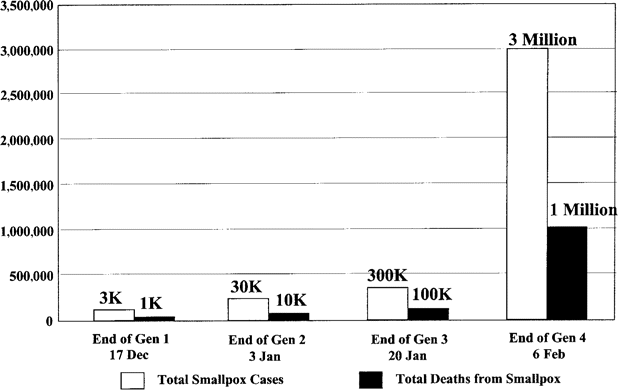
In the final act, “a prominent Iraqi defector claims that Iraq is behind the biological attack” and “the intelligence community deems his information highly credible.” Then,
The NY Times, Washington Post, and USA Today receive anonymous letters demanding the immediate removal (one week) of all US forces from Saudi Arabia and all war ships from the Persian Gulf. Failure to comply will result in renewed attacks on US, which will include anthrax, plague and small pox. Each letter also contained a genetic fingerprint of the smallpox strain matching the fingerprint of the strain causing the current epidemic.
Some have claimed that the above amounts to a prediction, several months in advance, of the 2001 anthrax attacks. The Dark Winter architects were certainly delighted at the coincidence, writing in their paper that these events prove that “Bioterrorism is no longer just the subject of war games.” Reasonable readers, I think, will agree that Dark Winter is just throwing every last bioterror scenario at the wall here. The possibility that the anthrax saboteur was inspired or influenced in some way by Dark Winter is nevertheless worth contemplating, for the attacks came from within the American biodefence establishment – precisely the audience for these theatrics.
Dark Winter borrows heavily from the 1972 Yugoslav smallpox outbreak, in which a recently vaccinated Albanian acquired smallpox on the Hajj and brought it back to Kosovo with him. The outbreak he seeded ultimately infected 175 people. The index patient is alleged to have infected only one person, a schoolteacher named Latif Mumdžić, though nobody could show that the two ever came into contact. Doctors initially failed to diagnose Mumdžić and he was shuttled around various hospitals and even shown to a group of medical students. This happened as he developed a terrifying hemorrhagic variant of smallpox disease known as black pox, which some sources allege is much more contagious. The superspreading event with which he is associated is known to have directly infected 38 people. Even if we assume, very improbably, that all other 135 cases were derived directly from those 38 infections, we get a reproduction number of at most 3.5 for variola-sans-superspreading, with 35 deaths yielding a case fatality rate of 20%.
These numbers are substantially better than the gloom-and-doom parameters of the Dark Winter scenario. It’s not very convincing to put the discrepancy down to the then-ongoing Yugoslav infant smallpox vaccination programme. Vaccine immunity is considered to wane substantially after five years, and anyway the scenario authors cite the Yugoslav outbreak specifically to justify their crazy inflated numbers. Later papers published after Dark Winter cast even more doubt on the simulation parameters. This 2002 study analyses historical data and places the variola reproduction number between 3.5 and 6, while this one from a year later looks at a well-documented 1967 Nigerian outbreak in an unvaccinated Christian community and finds an R-nought of 6.87 among the close contacts of infected persons.
Now, 6.87 may be less than 10, but it’s still pretty high. There is, however, an important catch here. No less a man than Henderson, in an older 1969 paper on a West African smallpox outbreak, noted that “Smallpox transmission appeared to stop when the supply of susceptible in prolonged intimate contact with the cases was exhausted,” even though “casual contact” persisted between infected persons and other susceptible villagers.
In other words: You get relatively high transmission as smallpox spreads among close contacts, but then very low transmission because smallpox has serious problems infecting people who encounter the virus only briefly. All over the literature is the observation that smallpox beyond the level of confined outbreaks seems to move rather slowly. While biowarfare ghouls are committed to the idea that the virus is transmitted primarily via aerosols (the premise of variola-as-biowarfare-agent depends on it), I find the shopping mall attacks envisioned by Dark Winter to be rather implausible. Everything suggests that you get smallpox not from fleeting inhalation of aerosols, but from prolonged proximity to infected family members.
The scenario authors imagine that unrecognised spread after the initial infections would be a serious problem.
[B]y the time a covert attack is discovered, the disease will already be spreading to the next generation of cases, known as “second-generation” cases. Given that very few doctors currently practicing medicine have ever seen a case of smallpox, and given that there is currently no widely available, rapid diagnostic test for smallpox, it is likely that the diagnosis of initial smallpox cases will be delayed, further promoting spread of disease.
This too seems wrong. All the evidence is that transmission happens in a narrow window after the distinctive rash emerges – that is, patients are most infectious when they are also the most easily diagnosed. In the stealthier pre-rash, febrile stages of infection, almost no spread happens. A real smallpox attack, therefore, would result in some secondary infections at hospitals and among familial contacts, but whatever anybody did, the outbreak would slow substantially thereafter. Henderson and his fellow CCBS smallpox imaginers knew this, and yet they deliberately endowed smallpox with vastly more contagious properties in Dark Winter simply to sow anxiety about the virus and the possibility of its re-emergence.
A final, more conspiratorial observation: It’s interesting that smallpoxians like Henderson were developing public anxiety about the re-emergence of variola around the year 2000, around a generation after infant smallpox vaccinations had ceased in the United States. Perhaps their concerns were more than opportunistic efforts to ride the bioterror bandwagon. Smallpox is extremely durable in the environment; the virus can remain viable for multiple years in patient scabs. Its environmental durability appears related to its pathogenicity; in the terminology of Paul Ewald, it pursues a “sit-and-wait” strategy, which affords it the ability to cause very severe disease without ever quite burning itself out. Human-to-human transmission therefore happens primarily among immediate contacts in a given outbreak. To spread from outbreak to outbreak, however, variola needs to lurk in the environment and wait opportunistically for a new host. Is it a coincidence that the only virus ever eradicated via human efforts is precisely one of those rare viruses capable of lurking unnoticed in the environment for years until it can find somebody new to infect? Perhaps the question in 2000 – after infant smallpox vaccination had stopped and population immunity dropped to nearly zero – was whether smallpox would come back.
Here at the bottom, the scorecard.
Seriousness: Post Iraq-war investigations have shown that, contrary to the 1999 intelligence assessment, Iraq terminated all bioweapons research after 1996, out of fear of international repercussions. Saddam Hussein maintained public ambiguity about this decision for purposes of deterrence, but there is no evidence at all that he ever sought to weaponise smallpox. The shopping mall attack also strikes me as highly implausible and unlikely to work as envisioned. The authors of Dark Winter could have designed a vastly more serious outbreak scenario, but that would hardly have served their interests or the interests of their collaborators. This is badly written bio-terror fiction designed not to be realistic, but to make an impression on policymakers and the media.
Prescience: I will award a few points for anticipating the 2001 anthrax attacks, but not many. I don’t see much that is relevant for the 2020 pandemic response here at all, aside from school closures (an idea which has been current in American public health circles since it was tried in 1918) and limits on public gatherings. There is not the slightest hint of mass containment here. The scenario imagines that non-pharmaceutical interventions might slow infections, but never conceives that they will “crush the curve.” Once again, Dark Winter is structured such that infections progress regardless of what the participants do.
Rigour: Dark Winter was designed by a central pandemicist institution, and unlike the sad jokes that are SPARS and “Lock Step,” it is in touch with contemporary epidemiological research, though this is often misrepresented for the purposes of maximum doom.
Comedic value: Absolutely none, the biowarfare ghouls are a plague on the land and if smallpox ever re-emerges I have no doubt that it will be their fault.
Scorecard
- Seriousness: 3/10
- Prescience: 3/10
- Rigour: 8/10
- Comedic value: 0/10